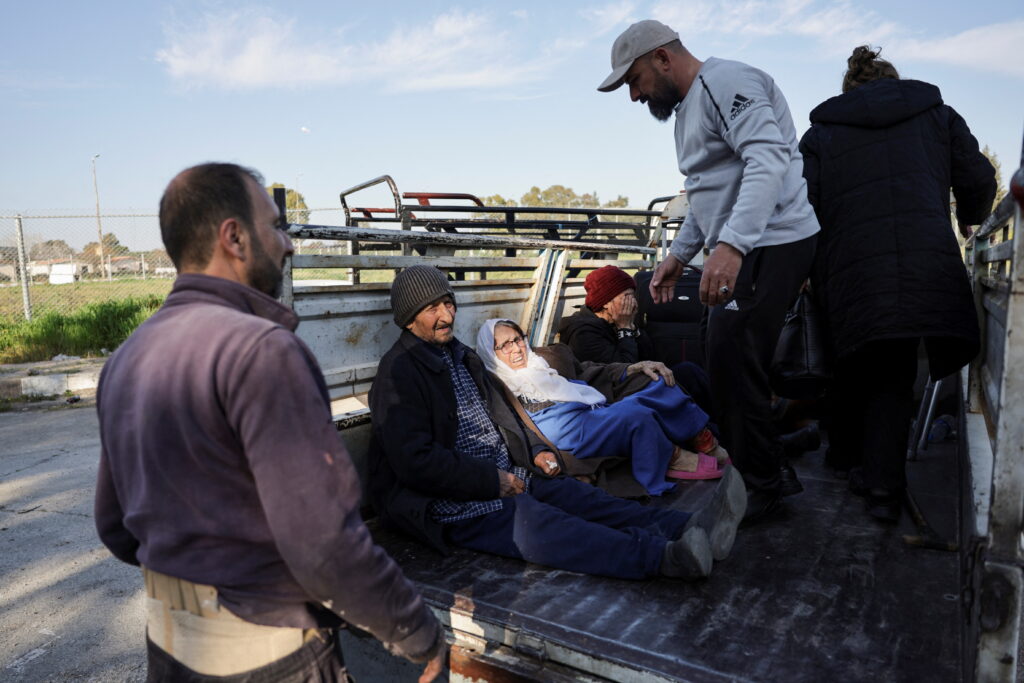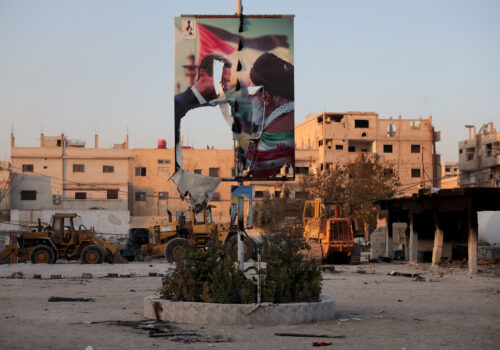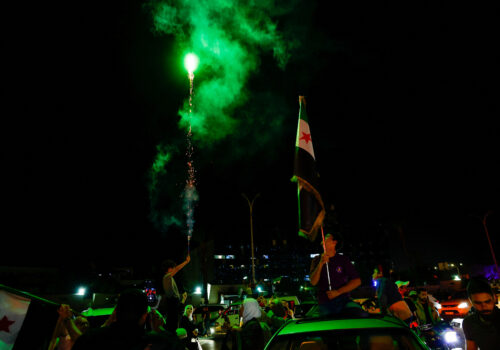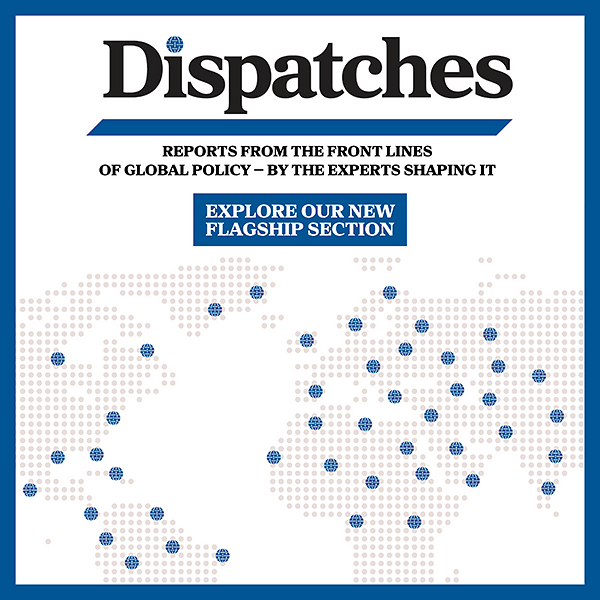Sectarianism, social media, and Syria’s information blackhole
The first state-sponsored television news channel to air in Syria since the fall of Bashar al-Assad’s regime went live on May 5th, opening with a panel discussion between the governor of Suwayda and two prominent Druze leaders on the governorate’s ongoing security crisis. The launch of al-Ikhbariya is one small step in building back communication channels on security and governance across the country, but much more work must be done.
Since Assad’s December ousting, Syrians have struggled to sift the truth from fake claims about security incidents across the country and to find accurate information about local and central government decisions.
Under the Assad regime, all official media were state-run, overtly political, and heavily censored. Most Syrians instead relied on Facebook to obtain local news and avoid censorship. But since the regime’s collapse, many Syrians have struggled to keep up with current events, official decrees, and local news. Absent any clear official new channels, most Syrians turned to social media to fill the information void. This reliance on social media has predictably resulted in rampant misinformation and disinformation across the country. The flood of unverified news has been exploited by foreign actors as well, further exacerbating sectarian conflict and fears.
Nowhere is this more impactful than in Syria’s Alawite-majority coast—the minority group to which the Assad family belongs. These communities have, since December 8, relied on social media to both raise awareness of and look for sectarian crimes committed by civilians and security forces affiliated with the new government. But this ecosystem was immediately flooded with false and misleading claims of massacres and international intervention, bolstered by real events and confusing statements by the transitional authorities. All of this fueled panic and confusion even before the March 6 insurgent uprising and Alawite massacres that killed more than 1600 security forces and Sunni and Alawite civilians. Without access to a consistent stream of reliable news, Syrians of all sects have adopted divergent narratives of major security events and struggle to understand the diplomatic positions of foreign countries or assess their own security status in their regions. This uncertainty also extends to all details of the transitional, and now interim, government’s policies and security forces.
Utilizing two weeks of fieldwork across the coast and consistent monitoring and analysis of Syrian social media before and after the fall of the regime, this report provides anecdotal evidence of the issues and effects of the information ecosystem in Syria. This research followed a more loosely structured two weeks of fieldwork in the same areas in mid-February. Through this, three common themes of information sharing have emerged:
- Social media dominates the information ecosystem, from rumor mills to international misinformation campaigns.
- Locals and officials have utilized WhatsApp groups and Facebook pages to fill the communication void, but they have still failed to create clear lines of official communication.
- The media void has fueled fear, hatred, and sparked instability over security uncertainty. Parallel narratives of the current security situation have created further sectarian divisions.
“The biggest problem is Facebook”
In the nearly two decades since Facebook’s creation, the social media platform has evolved into thousands of community, group, and celebrity pages that often compete for followers and daily traffic. Facebook’s algorithms often promote these high-traffic, generic ‘news’ pages over more accurate, smaller-traffic local news pages, flooding Syrians with unverified clickbait-style news.
Facebook has for years been Syria’s dominant social media and news platform, a crucial medium for sharing information about and calling attention to crimes occurring in their communities. Misinformation was widespread from the revolution’s earliest days in 2011, and similar trends were quickly apparent in the chaos of the regime’s collapse.
SIGN UP FOR THIS WEEK IN THE MIDEAST NEWSLETTER
For example, local Salamiyah community pages quoted a General Security official on May 8, saying, “We urge our fellow citizens to exercise caution and refrain from engaging with any fake accounts or pages and to rely only on the official channels issued by the Ministry of Interior to disseminate security news and information.”
When asked how locals along Syria’s Alawite-majority coast accessed news about their region, the response was a resounding accordance of: “social media.”

Each governorate, village, and even neighborhood has experienced the fall of the regime and developments differently. Local news, perhaps even more so than national news, carries important implications for local safety, access to services, and impacts on daily life. For instance, information about the violence perpetrated by both the insurgents and the pro-government factions on March 6 became vital for survival, but fake claims muddied real events as everyone turned to social media for answers.
For many Alawites, all of these claims were taken together to prove the extent of a “genocide” against them in the aftermath of Assad’s fall. But as the fake claims were disproven, they became evidence for many Sunnis that the real deaths of Alawite civilians and crimes by pro-government forces must have also been faked. As a result, the two communities today have completely separate narratives of that week, and many attempts at interfaith dialogues since have devolved into debates over the basic facts.
One woman in Latakia put it simply: “The biggest problem is Facebook,” she told us.
The media environment in March was a microcosm of how fake news had been used since Assad’s downfall to push divergent realities between the pro and anti-new government communities. But this misinformation goes beyond local initiatives and rumors.
Recent investigations by the BBC, Arabi Post, Verify-Sy, and the German Marshall Fund have also underscored the role of foreign media campaigns backed by Iran, Israel, and Hezbollah to push sectarian narratives and fake news onlinee, including the rumors that Maher al-Assad was returning to the coast with the Russian army at his back, ready to reclaim Syria.
And as real violence against Alawites escalated in Homs in January and February, this disinformation ensured that Alawites in other areas like Latakia and Tartous, which had not seen any considerable violations, remained confused and terrified about their future safety. Promises from pro-Assad Alawite networks of an imminent international intervention by the United States, France, Israel, or the United Nations to either reassert Assad in Damascus or carve out an “Alawite Coastal State” were used to widen support for the growing anti-Damascus insurgent movement, culminating in widespread support or neutrality for the insurgent attacks in March.
A Christian businessman from Safita recalled the Maher rumor, pointing to the Alawite villages surrounding the city: “That night you could hear gunfire from every village here, they all believed he was returning and celebrated.” Other locals told the authors at the time how their Facebook feed had suddenly become full of Alawites threatening revenge on coastal Sunnis for opposing Assad. As a local from a village outside Tartous recalled, when the rumors began, gunshots were heard throughout the Khirbet al-Mazzah region, convincing the local General Security forces that they would soon come under attack. As the confusion threatened to escalate into armed conflict, Alawites in the village sheltered the security forces in their homes until the morning, ensuring the area remained calm.
Struggling official channels of communication
These social media rumors and foreign media campaigns spread fear and confusion across Syria’s minority regions by exploiting both the real sectarian violations and the government’s lack of official news channels. For its part, the new government has made some initial attempts to spread information about municipal news, but still struggles greatly at relaying clear security-related statements or establishing effective two-way communication channels so locals can clarify rumors.
The Tartous and Latakia Governorate Facebook pages, which were formed in mid-December 2024 and appear to be run by government employees, regularly post updates of meetings and activities conducted across the governorate. Yet these pages have relatively few followers, are overshadowed by much higher traffic privately-run pages, and do not resolve the fears of those who already distrust the government. The majority of people, when asked where they get official government news from, made no mention of such pages, instead relying on word of mouth and their own online networks.
It all leads to one question. As a Christian in Safita asked, “Who represents the government?”
Official communication for security issues is even more opaque.
While there is one official Ministry of Interior page, for example, there are dozens of Facebook pages that claim to represent the General Security Services, with no way to discern any of their affiliations.
Regardless, a single Ministry of Interior page does not address the vast majority of Syrians’ needs: detailed and up-to-date information on security issues. This is not just a problem of clear government communication, but also a lack of two-way communication, allowing locals to check rumors or events witnessed in their towns.
To address this, local officials in the cities of Latakia and Tartous created multiple WhatsApp groups to directly connect their communities to security and administrative officials on security developments.
A business owner in Latakia city who was among the first invited to the group claimed the system “was very useful in the early days of the new administration because of the rise in crime.” Residents will text in reports about robberies or suspicious activity, and security forces will respond in a timelier manner than when using phone lines, which he claimed were always busy. These groups have also become a central means for regional officials to disseminate news.
However, in Tartous, a female activist stated that the WhatsApp groups were almost entirely composed of men and were capped at four hundred people. As she wasn’t included in that limit, she would have to reach out to others to get information from or to the channel. The business owner from Latakia also voiced concerns about the size of the group, saying that some people were clogging the chat with non-security-related comments and would then have to be removed from the group by moderators.
While this approach improves some communication, many criticize this improvised system: “Why is an official decree distributed in a WhatsApp channel?” asks a Sunni activist in Tartous.
Confusion about official policies of the government, such as the settlement process for ex-regime soldiers, rules around civil society, curfews, and checkpoints, has forced many to lie low and wait anxiously for clarity. As a priest in Suqlabiyah stated, locals come to him with questions about what makes a war criminal: “There is confusion about who is going to be detained or killed.”
The rift between realities
In Latakia, some Sunnis who spoke with the authors were unsure what to think about the news of the massacres on the coast. They don’t know or perhaps don’t want to know if civilians were killed. Meanwhile, in Baniyas, many survivors argue that there were no insurgents in the city, but rather it began with a government-sanctioned slaughter. These conflicting realities continue to be fought online, but the Facebook quarrels have real-life consequences.
During the long years of Syria’s civil war, many regions became isolated and rooted in their local realities of struggle. As al-Sharaa’s forces seized the country, many were optimistic, though they knew little of his government in Idlib. However, as the new government settled in and in light of the violence on the coast and elsewhere, the initial hope has faded into distrust and confusion. Those interviewed had more questions than answers about the various security forces and their origins, the factions from the north, life in Idlib under al-Sharaa’s militant group Hayat Tahrir al-Sham, the ideology of the current government, and the conditions in nearby governorates.
Officials are deeply aware of this—one security officer in Qadmus told us that “combatting fear is a major issue.”
This uncertainty about the future has heightened sectarianism based on the regime’s careful weaponization of Syria’s demographic makeup. Fear of military checkpoints has further isolated many Alawites, while Facebook rumors about roving foreign fighters and factions committing daily crimes against Alawites have prevented most from engaging with local security officials. Distrust in the government, in hand with their resounding silence on the specifics of the events of March 6, has left Syrians to piece together their own narratives, further separating the country into distinct realities.
Reconstructing the Syrian information ecosystem
Breaking Syria from Facebook’s grasp will not be easy or quick. However, the Syrian authorities and international organizations can take several steps to help begin the process.
First, ensuring that the March 6 Investigation Committee releases an accurate and uncensored report on the events of that week will go a long way towards bridging a trust gap between the Sunni and Alawite narratives, as most Sunnis who denied the deaths of Alawite civilians also told the authors that they would accept whatever conclusion the committee came to.
Second, expanding civil communication networks will help foster more accurate and effective local news systems. This can include both word-of-mouth via civil councils that engage with local officials, as well as local journalists on Facebook. Expanding these systems requires funding support from the international community and clear authorization from Damascus to ensure local civil networks do not face any risk of legal troubles.
Third, expanding official government media channels to include local security announcements, such as curfews, deployments, and patrols, and, importantly, addressing any violations or crimes rumored to have been committed by security forces.
Lastly, international organizations should increase funding for local media outlets, especially those engaged in fact-checking and who demonstrate professional standards in what they share. Helping existing journalists organize into new institutions with websites outside of Facebook will further bolster their credibility and reach.
Gregory Waters is a researcher at the Syrian Archive and an independent analyst whose research focuses on the development and reform of security institutions, local governance initiatives, and sectarian relations.
Kayla Koontz is a PhD candidate at the Carter School for Conflict Analysis and Resolution and a researcher at the Syrian Archive.
Further reading
Thu, May 8, 2025
From rubble to rebirth: A model for Syria’s reconstruction
MENASource By
Almost six months since Assad regime collapse, four key pillars will determine whether this new Damascus can seize the opportunity.
Tue, May 13, 2025
Experts react: Trump just announced the removal of all US sanctions on Syria. What’s next?
New Atlanticist By
Our experts provide their insights on how the removal of US sanctions on Syria would affect the country and the wider region.
Tue, Apr 29, 2025
Why the US must not let Syria slip away
MENASource By
Reconsidering the uneasy US-Syria relationship amid reports that Trump and al-Sharaa will meet during the US president's Saudi Arabia visit.
Image: A Syrian man points at bullet holes in a window of a hospital in Jableh town, 25 km south of Latakia, following a spate of violence between Syrian security forces and insurgents loyal to deposed president Bashar al-Assad in Syria's coastal region. Syrian authorities say they have halted a military operation along the country's western coastline designed to quell a surge in violence that is reported to have claimed hundreds of lives.



